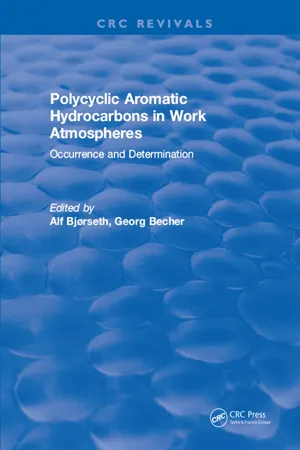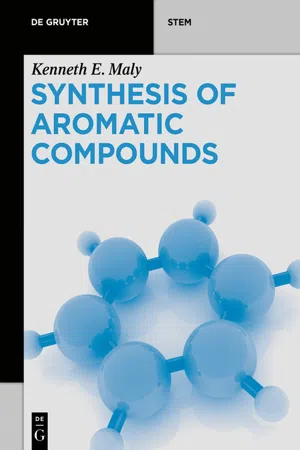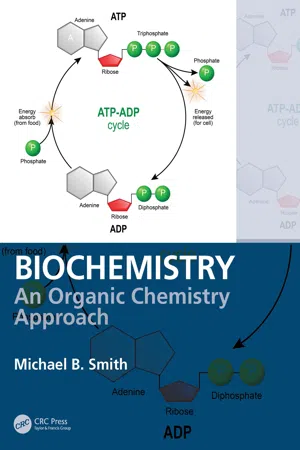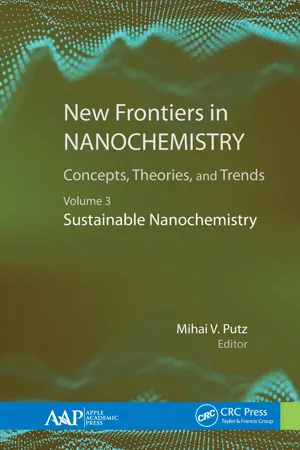Chemistry
Phenanthrene
Phenanthrene is a polycyclic aromatic hydrocarbon composed of three fused benzene rings. It is a colorless, crystalline solid with a characteristic aromatic odor. Phenanthrene is found in coal tar and is used in the production of dyes, pharmaceuticals, and as a research tool in organic chemistry.
Written by Perlego with AI-assistance
5 Key excerpts on "Phenanthrene"
- eBook - ePub
Polycyclic Aromatic Hydrocarbons in Work Atmospheres
Occurrence and Determination
- Alf Bjorseth(Author)
- 2018(Publication Date)
- CRC Press(Publisher)
Chapter 3 PHYSICAL AND CHEMICAL PROPERTIES OF PAH I. CHEMICAL STRUCTURE AND NOMENCLATUREPAH consist of three or more benzene rings interlinked in various arrangements. The entire group of PAH can be divided into kata-annellated and peri-condensed systems. In kata-annellated PAH, the tertiary carbon atoms are centers of two interlinked rings, e.g., anthracene (1), whereas in peri-condensed PAH, some of the tertiary C atoms are centers of three interlinked rings, e.g., pyrene (2). Annellation can be linear (anthracene, 1) or angular (Phenanthrene, 3).The theoretically possible number of PAH is tremendous. Table 1 shows the number of possible isomers which consist exclusively of six-membered rings, as a function of the number (n) of rings.1 There are 683,101 theoretical possibilities for the linking of 12 rings alone. PAH may also contain five-membered rings, as in fluorene and fluoranthene, giving rise to a further great number of different PAH and structural isomers. In addition, alkyl groups may be attached to various positions of the unsubstituted parent PAH. These principal structural elements are encountered in mixed systems in an almost unlimited number of permutations. This large number of different PAH and isomers calls for a systematic, unambiguous nomenclature.Nowadays, the proposals given by the International Union of Pure and Applied Chemistry (IUPAC) are generally used. Details of the rules for nomenclature of PAH have been published in The Ring Index.2 A short summary of the IUPAC rules is given below.1. A limited number of base components are given trivial names, e. g., anthracene, pyrene.2. The peripheral numbering is dictated by placing the PAH so that the maximum number of rings lie in a horizontal row, and as many rings as possible are above and to the right of the horizontal row (see Figure 1 - eBook - ePub
Conjugated Objects
Developments, Synthesis, and Applications
- Atsushi Nagai, Koji Takagi(Authors)
- 2017(Publication Date)
- Jenny Stanford Publishing(Publisher)
2.1). The fusion of three benzene rings gives two isomers, depending on their connectivity. One is anthracene, which consists of three ortho -fused benzene rings in a linear arrangement. Another is Phenanthrene, in which naphthalene is fused with a benzene ring at the C1-C2 bond to form a bent structure. Further annelation of benzene ring(s) to anthracene in a linear manner gives the so-called [ n jacenes such as tetracene and pentacene. A zigzag annelation of benzene ring(s) to Phenanthrene affords [ n jphenacenes such as chrysene and picene. These [ n jacenes and [ n jphenacenes possess planar structures and demonstrate promising properties as organic semiconductors for OFETs. On the other hand, an angular annelation of benzene ring(s) to Phenanthrene gives [ n jhelicenes with nonplanar helical structures. [ n jHelicenes composed of six or more benzene rings exhibit stable helical chirality because of an intramolecular steric repulsion, which endows them with unique chiroptical properties. Heteroaromatic rings are also important modules for fused π-conjugated compounds since the introduction of heteroatom(s) into a π-conjugated framework is an effective way to control the electronic structure of them. In particular, thiophene-fused compounds have been well-studied in terms of synthesis and application as organic functional materials. For example, a series of thiophene-fused pentacyclic aromatic compounds were synthesized and found to demonstrate high semiconducting properties. Representative examples are shown in Fig. 2.2. In these compounds, benzene and/or thiophene rings are annelated in a linear fashion. Accordingly, these compounds are called as thienoacenes. Anthra[2,3- h :6,7- h ’]dithiophene (1) is apparently isoelectronic with pentacene, the corresponding pentacyclic hydrocarbon acene. However, compounds 2 and 3 should be considered not as [ n ]acenes but as [ n ]phenacenes in the sense of electronic structure - eBook - ePub
- Kenneth E. Maly(Author)
- 2022(Publication Date)
- De Gruyter(Publisher)
9 Fused aromatic rings – polycyclic aromatic hydrocarbons9.1 Introduction to polycyclic aromatic hydrocarbons
Polycyclic aromatic hydrocarbons (PAHs) are a diverse class of organic molecules. They are found in fossil fuels such as crude oil, coal, and oil shale, and are also produced during incomplete combustion. PAHs also present environmental concerns and are known to be carcinogenic.The historical motivations for the synthesis of PAHs include the production of quinone dyes, fundamental studies on the nature of aromaticity, and to further understand the carcinogenic properties of these compounds. More recently, a renewed interest in the synthesis of PAHs stems from their potential utility as organic semiconductors or light-emitting materials. By virtue of molecular properties such as a low HOMO–LUMO gap and the ability to interact via π-stacking interactions, these compounds can often transport charge, thereby serving as a potential alternative to inorganic semiconductors. As such, there is a considerable effort to develop new synthetic methods for the preparation of PAHs. In this chapter, we will explore some of the general features of PAHs, including reactivity and stability. We will also explore some of the general approaches for the synthesis of PAHs, which will form the basis for the synthetic applications discussed in Chapters 10 and 11. For a more detailed discussion of the synthesis and reactivity of PAHs, Clar and Harvey each have books focused entirely on the synthesis of PAHs [1 , 2 ].9.1.1 Classification and nomenclature of PAHs
PAHs are often classified based on how the rings are fused as cata-condensed systems, or as peri-condensed systems. Cata-condensed systems have ring fusions that only share two carbons (Figure 9.1 ). Peri-condensed systems have carbon atoms that serve as the fusion point for three rings (Figure 9.2 ).Figure 9.1: - eBook - ePub
Biochemistry
An Organic Chemistry Approach
- Michael B. Smith(Author)
- 2020(Publication Date)
- CRC Press(Publisher)
9 Aromatic Compounds and Heterocyclic CompoundsBenzene is a special type of hydrocarbon. Derivatives are known by replacing the hydrogen atoms of benzene with substituents and/or functional groups. There are hydrocarbons related to benzene that have two, three, or more rings fused together (polycyclic compounds). The unifying concept of all these molecules is that they are aromatic, which means that they are especially stable with respect to their bonding and structure.9.1 Benzene and Aromaticity
Benzene is a hydrocarbon with the formula C6 H6 . It is the parent of a large class of compounds known as aromatic hydrocarbons. The structure and chemical reactivity of aromatic hydrocarbons are so unique that benzene derivatives are given their own nomenclature system. This discussion will begin with the unique structure of benzene.The structure of benzene is shown in Figure 9.1 . It is known that the C—C bond length in ethane is 1.53 Å (153 pm), and the C—C bond length is 1.536 Å (153.6 pm) in cyclohexane. The bond distance for the C=C bond in ethene is 1.34 Å (134 pm). These data indicate that a C=C unit has a shorter bond distance than a C—C unit. If benzene has a structure with both single and double bonds, it should have three longer C—C single bonds and three shorter C=C units. It would then be called cyclohexatriene. It has been experimentally determined that all six carbon–carbon bonds have a measured bond distance of 1.397 Å (139.7 pm), a value that lies in between those for the C–C bond in an alkane and the C=C unit of an alkene. This observation means that the C–C bonds in benzene are not single bonds, nor are they C=C double bonds where the π-electrons are localized between two carbons in a π-bond. This molecule is not cyclohexatriene, it is benzene . Each carbon in benzene is sp2 hybridized, however, which means each has a trigonal planar geometry. The planar geometry is seen more clearly in the molecular model of benzene in Figure 9.1 - eBook - ePub
New Frontiers in Nanochemistry: Concepts, Theories, and Trends
Volume 3: Sustainable Nanochemistry
- Mihai V. Putz(Author)
- 2020(Publication Date)
- Apple Academic Press(Publisher)
CHAPTER 21 Polycyclic Aromatic Hydrocarbons (PAHs) MARINA A. TUDORAN, 1, 2 ANA-MARIA PUTZ, 1, 3 LAURA PITULICE, 1 and MIHAI V. PUTZ 1, 2 1 Laboratory of Structural and Computational Physical Chemistry for Nanosciences and QSAR, Biology-Chemistry Department, West University of Timisoara, Pestalozzi Street No. 44, Timisoara, RO–300115, Romania 2 Laboratory of Renewable Energies-Photovoltaics, R&D National Institute for Electrochemistry and Condensed Matter, Dr. A. Paunescu Podeanu Str. No. 144, Timisoara, RO–300569, Romania 3 Institute of Chemistry Timisoara of the Romanian Academy, 24 Mihai Viteazul Bld., Timisoara 300223, Romania 21.1 DEFINITION Polycyclic aromatic hydrocarbons (PAHs) represent a class of organic compounds with three or more fused benzene rings containing only carbon and hydrogen, produced by incomplete combustion or high-pressure processes, i.e., when complex organic substances are exposed to high temperatures or pressures. 21.2 HISTORICAL ORIGIN(S) PAHs represent a class of organic compounds, having two or more bonded benzene rings in one of the three forms (Arey and Atkinson, 2003; Di-Toro et al., 2000): linear, angular or cluster arrangements (see Figure 21.1). They have an interesting characteristic: they bond with hydrogen atoms and forms aromatic rings similar to graphite (Putz et al., 2013). As a mechanism of formation, PAHs have different sources, such as products of incomplete combustion from man-made combustion sources, natural combustion sources or biological processes (Abdel-Shafy and Mansour, 2016). They are solid compounds, white, and pale yellow or colorless, with low vapor pressure and high boiling and melting points (Masih et al., 2012)
Index pages curate the most relevant extracts from our library of academic textbooks. They’ve been created using an in-house natural language model (NLM), each adding context and meaning to key research topics.
Explore more topic indexes
Explore more topic indexes
1 of 6
Explore more topic indexes
1 of 4




